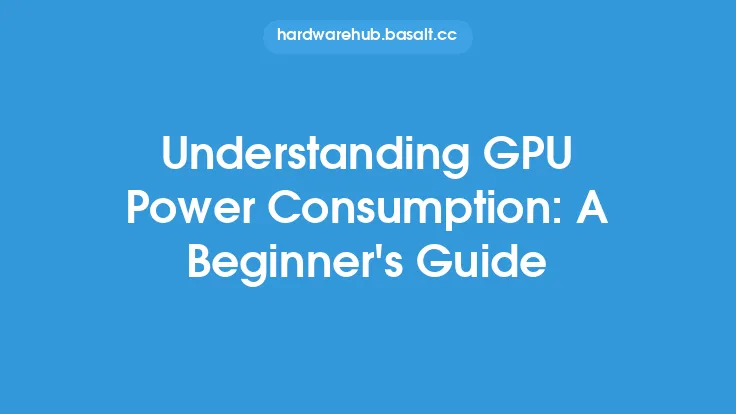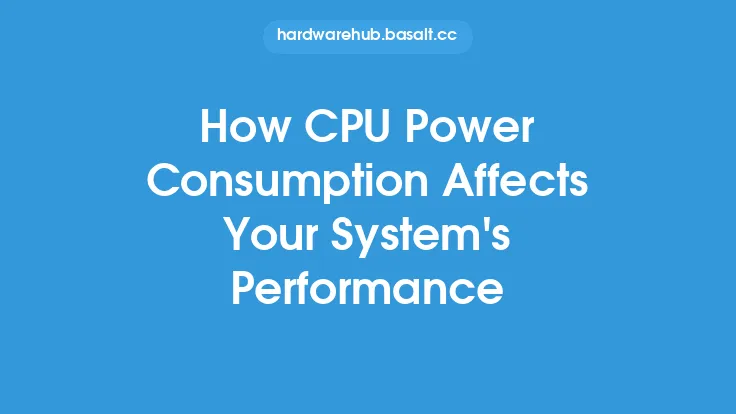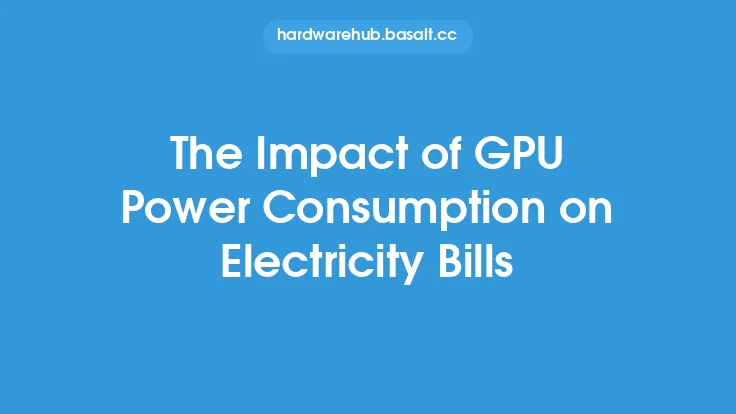Measuring GPU power consumption accurately is crucial for various reasons, including optimizing system performance, reducing energy costs, and ensuring reliable operation. Graphics Processing Units (GPUs) are among the most power-hungry components in modern computers, and their power consumption can significantly impact the overall energy efficiency of a system. In this article, we will delve into the details of measuring GPU power consumption accurately, exploring the various methods, tools, and techniques involved.
Introduction to GPU Power Measurement
GPU power consumption can be measured using various methods, each with its own set of advantages and limitations. The most common methods include using built-in GPU monitoring tools, external power measurement devices, and software-based power estimation techniques. Built-in GPU monitoring tools, such as NVIDIA's GPU-Z or AMD's GPU-Tech, provide detailed information about the GPU's power consumption, temperature, and other performance metrics. However, these tools may not always provide accurate power consumption measurements, as they rely on the GPU's internal power monitoring capabilities, which can be affected by various factors, such as driver versions and system configurations.
Hardware-Based Power Measurement Methods
Hardware-based power measurement methods involve using external devices to measure the power consumption of the GPU. These devices can be connected to the system's power supply or directly to the GPU's power connectors. One popular method is to use a digital multimeter (DMM) to measure the voltage and current drawn by the GPU. By multiplying the voltage and current values, the power consumption can be calculated. Another method is to use a power meter, such as a Kill A Watt or a Watts Up? meter, which can provide accurate measurements of the system's power consumption. These devices can be connected to the system's power supply or to a power distribution unit (PDU) to measure the power consumption of the entire system or individual components.
Software-Based Power Estimation Techniques
Software-based power estimation techniques involve using algorithms and models to estimate the power consumption of the GPU based on various performance metrics, such as clock speeds, voltage levels, and workload characteristics. These techniques can be implemented using software tools, such as GPU power estimation software or system monitoring software. One popular software-based power estimation technique is to use the GPU's performance counters to estimate its power consumption. Performance counters provide detailed information about the GPU's activity, such as the number of instructions executed, memory accesses, and texture mappings. By analyzing these counters, the power consumption of the GPU can be estimated with reasonable accuracy.
Calibration and Validation of Power Measurement Methods
Calibration and validation of power measurement methods are crucial to ensure accurate measurements. Calibration involves adjusting the measurement method to account for any errors or biases, while validation involves verifying the accuracy of the measurements against a known reference. For hardware-based power measurement methods, calibration can be performed by measuring the power consumption of a known load, such as a resistor or a calibrated power source. For software-based power estimation techniques, calibration can be performed by comparing the estimated power consumption with actual measurements obtained using hardware-based methods. Validation can be performed by comparing the measurements with those obtained using other methods or with published data from the manufacturer.
Factors Affecting Power Measurement Accuracy
Several factors can affect the accuracy of power measurement methods, including the resolution and accuracy of the measurement device, the sampling rate and duration, and the system's power supply and configuration. The resolution and accuracy of the measurement device can significantly impact the accuracy of the measurements. For example, a DMM with a low resolution and accuracy may not be able to measure the power consumption of the GPU accurately, especially at low power levels. The sampling rate and duration can also impact the accuracy of the measurements. A high sampling rate and long duration can provide more accurate measurements, but may also increase the complexity and cost of the measurement setup. The system's power supply and configuration can also affect the accuracy of the measurements. For example, a power supply with a high efficiency and low ripple can provide more accurate measurements, while a system with multiple power-hungry components can make it more challenging to measure the power consumption of the GPU accurately.
Best Practices for Measuring GPU Power Consumption
To measure GPU power consumption accurately, several best practices should be followed. First, the measurement method should be calibrated and validated to ensure accuracy. Second, the system should be configured to minimize power consumption variability, such as by disabling unnecessary components and setting the GPU to a consistent performance state. Third, the measurement device should be selected based on its resolution, accuracy, and sampling rate, and should be connected to the system's power supply or to a PDU to measure the power consumption of the entire system or individual components. Fourth, the measurement duration should be sufficient to capture the power consumption characteristics of the GPU, such as its idle and load power consumption. Finally, the measurements should be analyzed and interpreted carefully, taking into account any errors or biases in the measurement method.
Conclusion
Measuring GPU power consumption accurately is a complex task that requires careful consideration of various factors, including the measurement method, system configuration, and power supply characteristics. By following best practices and using calibrated and validated measurement methods, accurate measurements of GPU power consumption can be obtained, providing valuable insights into the energy efficiency of the system and opportunities for optimization. Whether you are a system builder, a gamer, or a datacenter operator, accurate measurements of GPU power consumption are essential for optimizing system performance, reducing energy costs, and ensuring reliable operation.





